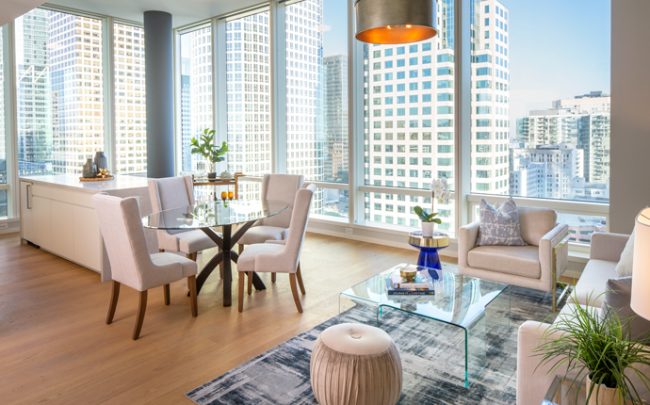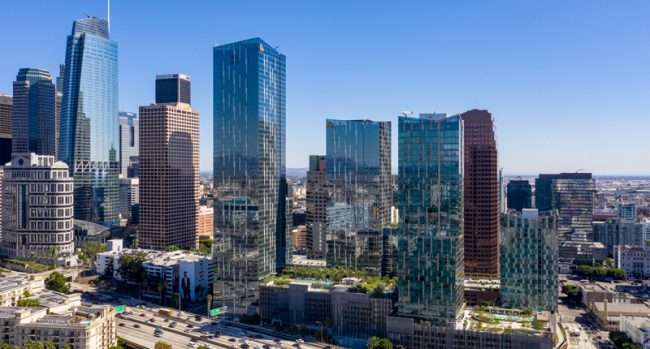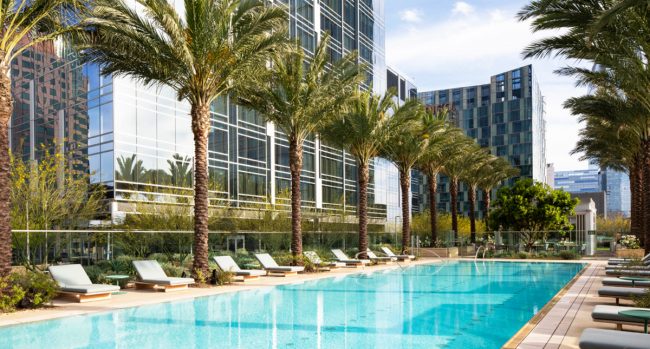It was two days before Halloween, and for Kimberly Lucero that meant a sales opportunity.
Sporting a gothic dress, princess crown, ruby ring, and spider necklace with blood red paint on her chest and forehead, Greenland USA’s vice president of sales and marketing conducted a condominium tour.
Lucero was showcasing units on the 12th floor of one of four towers that make up the Metropolis project, a 3.3-million-square-foot development three blocks south of the Staples Center that has reshaped the downtown Los Angeles skyline.
Before Lucero came on board in May, Greenland largely sold units to Chinese buyers, but that pool has shrunk dramatically.
“We had a good majority of international buyers,” Lucero said. “Then, it kind of shifted, and we started having a lot of people who are going to school. We have a lot of undergrad buyers who are going to USC, and who are driving their Porsche to school.”

Greenland USA’s vice president of sales and marketing Kimberly Lucero
Lucero, a sales veteran who joined Greenland after three years with condo developer CIM Group, was dead serious about this characterization of Metropolis’ new buying pool.
In fact, the condos up for grabs at the Halloween open house seemed targeted to either out of towners’ stereotypes of Angelenos, or college students that appeared in Bret Easton Ellis novels.
Walking through one condo, Lucero remarked, “This unit is for an Instagram influencer.” By another, she said, “This is for a student surfer.”
High prices, and a retreating market
Greenland USA saw itself making a grand Los Angeles imprint through the 1,500 luxury units and opulent hotel that would comprise the four-tower Metropolis project. But slow condo sales, a revolving door of brokers, an unsold hotel, and larger market challenges have complicated that vision.
There are two particular challenges the development team acknowledge they must overcome.
The first is China’s pullback from the U.S. real estate market.
“The Chinese were the biggest buyers at Metropolis,” said Christiano Sampaio, a broker at downtown real estate agency Loftway. “The investment crackdown has definitely taken a toll on the project.”
The second issue is that few believe downtown Los Angeles can absorb the amount of luxury product on the market. Sampaio’s research shows that downtown condo sales are slowing down, and the median unit is selling for about 30 percent less than Metropolis’ typical per square foot listing price.
“The Metropolis development never made sense in the first place,” said Richard Green, director at the USC Lusk Center for Real Estate. “There is a mismatch between the product that is downtown and the demand.”
“A lot of companies don’t even get that far”
Metropolis, which was Greenland’s first investment in the U.S., seemed off to a good start. Greenland purchased the 6.3-acre site at 9th and Francisco streets in 2013 for about $150 million and began construction in February 2014. The company gave itself a five-year timeline to complete the four towers, which range from 19 to 28 stories.
Three of the towers are done, and the fourth is slated to finish by the end of 2019, Lucero said.
Greenland’s ability to get the towers built sharply contrasts with other Chinese megadevelopers in downtown Los Angeles. Most notably, construction has stalled at Shenzhen-based Oceanwide Holdings’ Oceanwide Plaza downtown residential tower, and Shanghai-based Shenglong Group’s residential skyscraper in South Park.

The Agency’s Mike Leipart (Credit: The Agency Creates)
“Listen, here’s a foreign company, they came to the U.S. and California, a place with different guidelines and rules, and they built a massive project,” said The Agency’s Mike Leipart, who served as Metropolis’ lead sales agent before Greenland replaced the brokerage in January. “A lot of companies don’t even get that far.”
The trouble has been the next steps.
Amid sluggish condo sales, Greenland put two of the four Metropolis towers up for sale last year. The firm sought $280 million for the Hotel Indigo, but the tower never sold and a spokesperson said it has been taken off the market. Greenland also tried to sell Metropolis III, the largest of the four towers at 685 units, at an undisclosed asking price, rumored to be $450 million. That too didn’t sell, and Greenland is projected to finish construction this month. Except instead of condos, it’s now slated to be a rental building.
Greenland announced the switch to apartments in October, stating that it would turn over management of the fourth tower to Greystar Real Estate Partners, which is slated to start leasing units this month.
A move to rentals could make profitability a distant goal.
“It could have cost about $600 per square foot to build the units,” USC’s Green said. “Most apartments around there, the entire unit rents for around $2,000 a month, so that could be a pretty big loss.”
Lucero defended the decision to switch to rentals. “You shouldn’t dedicate everything to one type of product,” she said. “To be able to offer a for-sale, and for-rent product just fills the need of what is happening here.”

Greenland Holdings’ chairman/president Zhang Yuliang
The tactical change at Metropolis comes amid a bigger strategic shift in the U.S. for Greenland, one of China’s biggest developers. The company, founded in 1992 to create real estate developments within green spaces around Shanghai, has struggled with its New York megaproject, a 16-building development now known as Pacific Park (formerly Atlantic Yards). It also abandoned a $2 billion planned biotech building in San Francisco as well as twin residential towers in North Hollywood.
Though it produced $2.5 billion in net income over the first three quarters of 2019, Greenland’s long-term debt stands at $21.6 billion, at a time when the Chinese government is pressuring companies to reduce debt.
Greenland appears to have funded most of the Metropolis project through bond issuances overseas, according to a review of financial statements by The Real Deal. Public filings show that the megaproject has cost $1.26 billion, about $260 million more than first projected. Last year, Natixis and L.A.-based real estate investment firm Cottonwood Group provided Greenland a $310 million loan in order to complete the now rental Metropolis III.
People attribute the investment decrease to Trump, but it was really the Chinese crackdown on cash outflows.
The developer also took in about $100 million from the federal EB-5 program, in which foreign investors pour money into job-creating U.S. real estate projects in exchange for a green card. Visa wait times for Chinese investors have swelled to up to about 15 years, and developers these days seldom are able to take advantage of the program.
Greenland flatly dismissed any money concerns at Metropolis. “Financing is not a problem for us,” Lucero said.
The disappearing Chinese buyer
For years, Greenland, like several other developers, banked on Chinese buyers scooping up units at over $1,000 a foot, a premium in a developing submarket like DTLA.
“For a while in L.A.,” one real estate agent said, “when a unit would be priced way over market, sellers would say: ‘Well, someone from China might buy it.’”
Those buyers are long gone, observers said.
“People attribute the investment decrease to Trump, but it was really the Chinese crackdown on cash outflows,” said Jim Butler, a partner at the law firm Jeffer Mangels Butler & Mitchell.
Chinese investment in U.S. residential real estate plunged 56 percent year-over-year to $13.4 billion in 2018, according to a National Association of Realtors report. California was particularly affected, according to Gay Cororaton, an economist with the trade group.
“Geography and family considerations are a factor in these investments,” Cororaton said. “I don’t see a bump again from Chinese buyers, unless maybe the trade relations improve.”
Greenland has not been hit as hard as some developers, according to Lucero, because “we were near completion when the investment slow down started.”
Dwindling Chinese cash is one factor behind a tepid downtown L.A. condo market.
Sampaio of Loftway compiled downtown condo buys over the last three years, with the 110 freeway serving as the northwest endpoint, and the 101 as the southeast barrier. The broker found that 399 residential units sold downtown in 2017 at a sales price of $692 per square foot.
Through Nov. 15, 272 units had sold during 2019, which would come out to 310 units if the sales pace continued until years end. That would be a 22 percent drop from 2017. And prices are stagnant – the average downtown condo in 2019 sold at $697 per square foot, compared to the about $1,000 per square foot listings at Metropolis.
Downtown is not yet a place where high income people want to live. It’s still a place for people who can’t afford to live on the West Side.Richard Green, director at the USC Lusk Center for Real Estate
A report on third-quarter DTLA condo sales is even more pessimistic, with data from appraisal firm Miller Samuel indicating that third-quarter absorption dropped 31 percent year-over-year.
Downtown is generally regarded as a Los Angeles development success story, starting with the Staples Center opening in 1999. But the thousands of units built at Metropolis and other projects over the past five years may represent an overreach.
“There is definitely more supply than demand on the downtown luxury condo side,” Sampaio said. “There has just been this rapid influx of building with developers thinking they need to do luxury to get a return on their investment.”
And while DTLA is becoming more of a destination, it is an odd fit with other luxury neighborhoods characterized by lush green spaces and ocean views.
“Downtown is not yet a place where high income people want to live,” Green said. “It’s still a place for people who can’t afford to live on the West Side.”
A revolving door of brokerages
According to Lucero, construction on the first condo tower was completed in 2017, with 75 percent sold (231 of the 308 units).
But at the second tower, the site of the Halloween open house, just 25 percent, or 130 of its 518 units, are spoken for.
All told, 361 of the 826 units, or 44 percent have sold. The 465 unsold units are listed at a median price of $885,000.
Condos at the Halloween open house were around that price, listed at about $1,000 per square foot.
Lucero said that the company is proud of its sales record, but three different brokerages suggests expectations haven’t been met.
Douglas Elliman was the first brokerage tasked with selling the Metropolis in 2014. It was replaced with The Agency, which was swapped out in early 2019 in favor of Polaris Pacific.
Elliman declined comment, and The Agency said in a statement that Metropolis was “the fastest-selling development in Los Angeles” during its tenure.
Privately, agents who worked on the project accused Greenland of being unreasonable, and not understanding the downtown market.
“We would sell five or six of these and be really proud of ourselves, and they would turn around and say, ‘Why didn’t you sell 20?’” one agent said.
Polaris Pacific has dedicated three agents full-time to the project, brokerage director John Pallante said. Among them is sales manager Mike Brizzolara, whose track record features selling out Trumark Urban’s Ten 50, a 25-story condo tower in downtown Los Angeles best known for its rooftop drone pad.
The San Francisco-headquartered brokerage is following Greenland’s lead.
“Our goals,” Pallante said, “are Greenland’s.”
Meet Maddie, Greenland’s Influencer dreamgirl
Those goals include acknowledging the new buyer pool with a provocative ad campaign, including descriptions of hypothetical buyers more specific than many dating profiles.

A bedroom for “Maddie,” a hypothetical Millennial buyer at Greenland’s Metropolis project in Downtown L.A.
Take a $715,000 (or $1,031 per square foot) listing at the Halloween open house that was marketed to a hypothetical millennial buyer named Maddie. “Just a few years out of school and Maddie is maximizing her influence. She has more than 100,000 Instagram followers. A freelance buyer for the hottest new labels, she works from her one-bedroom but is steps away from clients in the Fashion District.”
Or how about a $1.4 million ($1,088 per square foot) listing that hopes to lure “Dianne” and “Jim.”
“Dodger fans Dianne and Jim have season tickets. Their best friends Linda and Gene are longtime Clippers fans. The Staples Premiere entrance is five minutes away. After games they come back to this corner unit with 11-foot ceilings and stunning views.”
But real estate agents provided with the copy were not sure what to make of it, with a few asking if the pitch invited fair housing complaints.
“We just have to be very careful as agents not to be too narrow in who are marketing toward,” said Jonathan Holden, an agent at Compass who is not involved in the Metropolis sales.
Fair housing lawyers said there are no actionable offenses, unless a pattern could be proved showing exclusion of protected races and genders.
Others said Greenland and Polaris are doing what everyone else is doing.
“There is no one who doesn’t do this kind of thing,” The Agency’s Leipart said. “The young, female influencer is a stand-in for someone creative, a stand-in for someone who works from home, it’s a lot of things.”
Some even said the ads were smart. If a potential buyer really is a longtime Clippers fan, the copy could appeal to them. “The target now is people who like basketball,” Sampaio said.

A living room marketed to hypothetical buyers “Dianne and Jim,” sports fans who enjoy entertaining after a game at Dodger Stadium or the Staples Center.
Influencers and season ticket holders, though, can only sell so many units, and Lucero is hoping students are the ones that make a dent in sales, crediting them for being already 10 percent of all condo occupants.
“It has to do with parents feeling that their kids are in a secure place, with 24/7 security people here,” Lucero said.
“Marketing to college students is not a silly marketing tactic,” Leipart said. “It’s a thing.”
But not one that can fill hundreds of condo units unless prices are significantly knocked down, agents said.
Lucero seemed aware of her extraordinary sales challenge ahead, and, with Chinese buyers all but gone, she spoke of experimenting in finding different audiences for the Metropolis condos.
“I’ve been in downtown since the 1970s,” she said. “My parents used to own restaurants here. I’m a dinosaur here. I’ve watched it grow, and I love what developers have done with it. I want people to love downtown as much as I do.”
Correction: An earlier version stated that Pacific Park is a 17-building development. Though Atlantic Yards was initially approved as a 17-building development, it is now likely to be 15 towers and a sports arena. Greenland has also sold off several sites.


